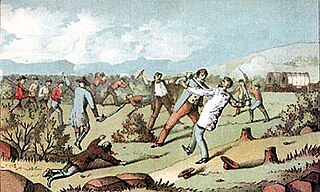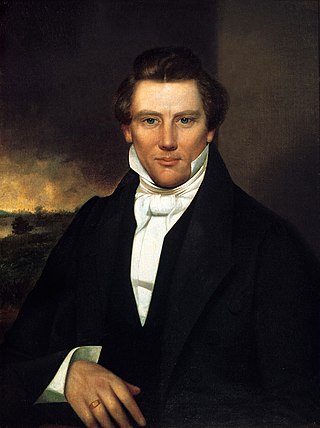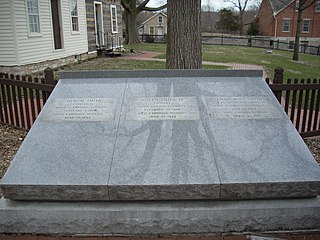|
The life of Joseph Smith from 1838 to 1839, when he was 33–34 years old, covers a period beginning when Smith left Ohio in January 1838 until he left Missouri and moved to Nauvoo, Illinois in 1839.
|
The life of Joseph Smith from 1838 to 1839, when he was 33–34 years old, covers a period beginning when Smith left Ohio in January 1838 until he left Missouri and moved to Nauvoo, Illinois in 1839.
Smith's early revelations identified western Missouri as Zion, the place for Mormons to gather in preparation for the second coming of Jesus Christ. Independence, Missouri, was identified as "the center place" and the spot for building a temple. [1] Smith first visited Independence in the summer of 1831, and a site was dedicated for the construction of the temple. Soon afterward, Mormon converts—most of them from the New England area—began immigrating in large numbers to Independence and the surrounding area.
The Latter Day Saints had been migrating to Missouri ever since Smith had claimed the area to be Zion. They simultaneously occupied the Kirtland area, as well as the Independence area for around seven years. Following the failure of the Kirtland Safety Society, Smith fled for Missouri in January 1838, and the rest of the remaining Latter Day Saints followed.
During this time, a church council expelled many of the oldest and most prominent leaders of the church—including Oliver Cowdery, John Whitmer, David Whitmer, and W. W. Phelps—on allegations of misusing church property and finance amid tense relations between them and Smith. [2] Smith explicitly approved of the excommunication of these men, who were known collectively as the "dissenters". [3]
In Missouri, the church also took the name "Church of Jesus Christ of Latter Day Saints", and construction began on a new temple. [4]
Political and religious differences between old Missourians and newly arriving Latter Day Saint settlers provoked tensions between the two groups, much as they had in Jackson County. Local leaders saw their Latter Day Saints as a religious and political threat, alleging that Smith and his followers would vote in blocs. Additionally, Mormons purchased vast amounts of land in which to establish settlements, and held abolitionist viewpoints, including Smith himself. Thus they clashed with the pro-slavery persuasions of the majority of Missourians. Tensions were fueled by the announcement by Smith that Jackson County, Missouri would be the New Jerusalem and that the surrounding lands were promised to the Church by God and that the Saints would inhabit that area.
By this time, Smith's experiences with mob violence led him to believe that his faith's survival required greater militancy against anti-Mormons. [5] Around June 1838, Sampson Avard formed a covert organization called the Danites to intimidate Latter Day Saint dissenters and oppose anti-Mormon militia units. [6] Though it is unclear how much Smith knew of the Danites' activities, he clearly approved of those of which he did know. [7] After Rigdon delivered a sermon that implied dissenters had no place in the Latter Day Saint community, the Danites forcibly expelled them from the county. [8]
In a speech given at Far West’s Fourth of July celebration, Rigdon declared that Mormons would no longer tolerate persecution by the Missourians and spoke of a "war of extermination" if Mormons were attacked. [9] Smith implicitly endorsed this speech, [10] and many non-Mormons understood it to be a thinly veiled threat. They unleashed a flood of anti-Mormon rhetoric in newspapers and in stump speeches given during the 1838 election campaign. [11]
On August 6, 1838, non-Mormons in Gallatin, Missouri, tried to prevent Mormons from voting, [12] and the election day scuffles initiated the 1838 Mormon War. Non-Mormon vigilantes raided and burned Mormon farms, while Danites and other Mormons pillaged non-Mormon towns. [13] In the Battle of Crooked River, a group of Mormons attacked the Missouri state militia, mistakenly believing them to be anti-Mormon vigilantes.
This battle led to reports of a "Mormon insurrection" and the death of apostle David W. Patten. In consequence of the reports of the battle, the burning out of ex-Mormon 'apostates' by the Danites, the attack on non-Mormons in Caldwell County, the sacking of Gallatin by the Mormons, and their reported plans to burn Richmond and Liberty, Missouri Governor Lilburn Boggs issued Missouri Executive Order 44, also known as the "Extermination Order" on October 27, 1838. The order stated that the Mormon community was in "open and avowed defiance of the laws, and of having made war upon the people of this State ... the Mormons must be treated as enemies, and must be exterminated or driven from the State if necessary for the public peace—their outrages are beyond all description." [14] The Extermination Order was not officially rescinded until June 25, 1976 by Governor Christopher S. Bond. [15]

Soon after the "Extermination Order" was issued, vigilantes attacked an outlying Mormon settlement and killed seventeen people. This event is identified as the Haun's Mill Massacre. Soon afterward, the 2,500 troops from the state militia converged on the Mormon headquarters at Far West. Smith and several other Church leaders surrendered to state authorities on charges of treason. [16] Although they were civilians, Smith was immediately brought before a military court, accused of treason, and sentenced to be executed the next morning, but Alexander Doniphan, who was Smith's former attorney and a brigadier general in the Missouri militia, refused to carry out the order. [17]
The legality of Boggs' "Extermination Order" was debated in the legislature, but its objectives were achieved. Most of the Mormon community in Missouri had either left or been forced out by the spring of 1839. Many found refuge in settlements in Illinois. Brigham Young –as president of the church's Quorum of the Twelve Apostles, one of the church's governing bodies–rose to prominence when he organized the move of about 14,000 Mormon refugees to Illinois and eastern Iowa. [18]
An estimated 800 Mormons were forcibly dispossessed of their homes and businesses. A long trail of appeals went as far as Washington, D.C., with Joseph receiving a personal audience with President Martin Van Buren, who said he could not help. Congress sent the matter back to the state of Missouri.
After losing the Mormon War (1838), Smith and other church leaders were then transferred to the jail at Liberty, Missouri, the Clay County seat, to await trial. Although he frequently called down imprecatory judgments on his enemies and perceived enemies, as Fawn Brodie has written, Smith bore his harsh imprisonment "stoically, almost cheerfully, for there was a serenity in his nature that enabled him to accept trouble along with glory." [19] Smith wrote to his followers "with skill and tact" attempting to dispel the now current notion that he was a fallen prophet. [20] Brigham Young later claimed that even Smith's brother William said he hoped that Joseph would never get out of the hands of his enemies alive. [21] Smith and his companions also made two unsuccessful attempts to escape from jail before, on April 6, they were started under guard to stand trial in Daviess County. [22]
Once the Latter Day Saints no longer posed a political threat, Missouri leaders realized that Mormon behavior could hardly be classified as treason whereas, as Fawn Brodie has written, the governor's "exterminating order stank to heaven." [23] On the way to trial, the sheriff and guards agreed to get drunk on whiskey purchased by Joseph's brother Hyrum and looked the other way while their prisoners escaped. [24]

Mormons are a religious and cultural group related to Mormonism, the principal branch of the Latter Day Saint movement started by Joseph Smith in upstate New York during the 1820s. After Smith's death in 1844, the movement split into several groups following different leaders; the majority followed Brigham Young, while smaller groups followed Joseph Smith III, Sidney Rigdon, and James Strang. Most of these smaller groups eventually merged into the Community of Christ, and the term Mormon typically refers to members of the Church of Jesus Christ of Latter-day Saints, as today, this branch is far larger than all the others combined. People who identify as Mormons may also be independently religious, secular, and non-practicing or belong to other denominations. Since 2018, the LDS Church has emphasized a desire for its members be referred to as "members of The Church of Jesus Christ of Latter-day Saints", or more simply as "Latter-day Saints".

The Danites were a fraternal organization founded by Latter Day Saint members in June 1838, in the town of Far West, Caldwell County, Missouri. During their period of organization in Missouri, the Danites operated as a vigilante group and took a central role in the events of the 1838 Mormon War. They remained an important part of Mormon and non-Mormon folklore, polemics, and propaganda for the remainder of the 19th century, waning in ideological prominence after Utah gained statehood. Notwithstanding public excommunications of Danite leaders by the Church and both public and private statements from Joseph Smith referring to the band as being both evil in nature and a "secret combination", the nature and scope of the organization and the degree to which it was officially connected to the Church of Christ are not agreed between historians. Early in the group's existence, Joseph Smith appeared to endorse its actions, but later turned against it as violence increased and the actions of the Danites inspired a hysteria in Missouri that eventually led to the Extermination Order. According to an essay on the website of the Church of Jesus Christ of Latter-day Saints, "Historians generally concur that Joseph Smith approved of the Danites but that he probably was not briefed on all their plans and likely did not sanction the full range of their activities."

Oliver H. P. Cowdery was an American religious leader who, with Joseph Smith, was an important participant in the formative period of the Latter Day Saint movement between 1829 and 1836. He was the first baptized Latter Day Saint, one of the Three Witnesses of the Book of Mormon's golden plates, one of the first Latter Day Saint apostles and the Assistant President of the Church.

The 1838 Mormon War, also known as the Missouri Mormon War, was a conflict between Mormons and non-Mormons in Missouri from August to November 1838, the first of the three "Mormon Wars".

Missouri Executive Order 44 was a state executive order issued by Missouri Governor Lilburn Boggs on October 27, 1838, in the aftermath of the Battle of Crooked River—a clash between members of the Church of Jesus Christ of Latter-day Saints and a unit of the state militia in northern Ray County during the 1838 Mormon War.

The Battle of Crooked River was a skirmish between Latter Day Saints forces and a Missouri state militia unit from southeast of Elmira, Missouri, in Ray County; the militia was under the command of Samuel Bogart. The battle was one of the principal points of conflict in the 1838 Missouri Mormon War. After the battle, the governor of Missouri issued Missouri Executive Order 44, sometimes called the "Extermination Order", which led to the expulsion of the Mormons from Missouri.

The salt sermon was an oration delivered on 17 June 1838 by Sidney Rigdon, then First Counselor in the First Presidency of the Church of Jesus Christ of Latter Day Saints, and frequent spokesman for Joseph Smith, the founder of the Latter Day Saint movement, against church dissenters, including Book of Mormon witnesses Oliver Cowdery, David Whitmer, and John Whitmer, and other leaders including W. W. Phelps. The Salt Sermon is often confused with Rigdon's July 4th oration.

The Eight Witnesses were one of the two groups of witnesses who made statements stating that they had seen the golden plates which Joseph Smith said was his source material for the Book of Mormon. An earlier group of witnesses who said they had seen the plates were called the Three Witnesses.

Zion's Camp was an expedition of Latter Day Saints led by Joseph Smith, from Kirtland, Ohio, to Clay County, Missouri, during May and June 1834 in an unsuccessful attempt to regain land from which the Saints had been expelled by non-Mormon settlers. In Latter Day Saint belief, this land is destined to become a city of Zion, the center of the millennial kingdom; and Smith dictated a command from God ordering him to lead his church like a modern Moses to redeem Zion "by power, and with a stretched-out arm."
John Corrill was an early member and leader of the Church of Jesus Christ of Latter Day Saints, and an elected representative in the Missouri State Legislature. He was prominently involved in the Mormon conflicts in Missouri before leaving the church in 1839 and publishing A Brief History of the Church of Christ of Latter Day Saints .

No Man Knows My History: The Life of Joseph Smith is a 1945 book by Fawn M. Brodie that was one of the first significant non-hagiographic biographies of Joseph Smith, the progenitor of the Latter Day Saint movement. No Man Knows My History was influential in the development of Mormon history as a scholarly field. However, scholars have since criticized the book for its methodological deficiencies, factual errors, and overt hostility to Smith.
The teachings of Joseph Smith include a broad spectrum of religious doctrines as well as political and scientific ideas and theories, many of which he said were revealed to him by God. Joseph Smith is the founder of the Latter Day Saint movement and is recognized by multiple Latter Day Saint churches as the founder. Beginning in 1828, Smith began dictating the text of what later became the Book of Mormon, and also began dictating written revelations he said were inspired by God.

The life of Joseph Smith from 1839 to 1844, when he was 34–38 years old, covers the period of Smith's life when he lived in Nauvoo, an eventful and highly controversial period of the Latter Day Saint movement. In 1844, after Smith was imprisoned in Carthage, Illinois, he was shot and killed when a mob stormed the jailhouse.

Sampson Avard was one of the founders and leaders of the Mormon vigilantes known as the Danites, which existed in Missouri during the Missouri Mormon War in 1838.
Cornelius Peter Lott was an early member of the Latter Day Saint movement, father of one of Joseph Smith's plural wives, a member of the Council of Fifty and a Danite leader.

Joseph Smith Jr. was an American religious leader and the founder of Mormonism and the Latter Day Saint movement. Publishing the Book of Mormon at the age of 24, Smith attracted tens of thousands of followers by the time of his death fourteen years later. The religion he founded is followed to the present day by millions of global adherents and several churches, the largest of which is the Church of Jesus Christ of Latter-day Saints.

Joseph Smith, the founder of the Latter Day Saint movement, was charged with approximately thirty criminal actions during his life, and at least that many financial civil suits. Another source reports that Smith was arrested at least 42 times, including in the states of New York, Ohio, Missouri, and Illinois.

The life of Joseph Smith, Jr. from 1831 to 1837, when he was 26–32 years old, covers the period of time from when Smith moved with his family to Kirtland, Ohio, in 1831, until he left Ohio for Missouri early in early January 1838. By 1831, Smith had already published the Book of Mormon, and established the Latter Day Saint movement. He had founded it as the Church of Christ, but eventually dictated a revelation to change its name to the Church of Jesus Christ of Latter Day Saints.

The legacy of Joseph Smith includes the immediate aftermath of Smith's killing, among various competing denominations, the status of his family and the church he founded, and a scholarly assessment of his life and religion. Although Smith was killed in 1844, he attracted thousands of devoted followers before his death, and millions in the century that followed. Among Mormons, he is generally regarded as a prophet on par with Moses and Elijah. In a 2015 compilation of the 100 Most Significant Americans of All Time, Smithsonian magazine ranked Smith first in the category of religious figures.